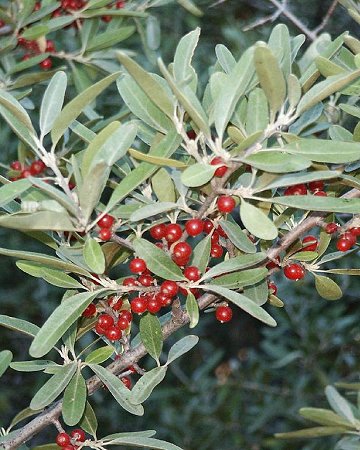
|
|
Buffaloberry
(Shepherdia argentea). Leaves and fruits
|
Buffaloberry -
Shepherdia argentea
Shepherdia argentea, commonly called silver buffaloberry, bull berry, or thorny buffaloberry, is a species of
Shepherdia. It is native to central and western North America, from southern Canada (Alberta, Saskatchewan, Manitoba) southwards in the United States to northern California, Arizona, and New
Mexico. It is commonly found growing in open woods, prairie
valleys, dry eroded hillsides and along river and stream edges.
Shepherdia argentea is a deciduous shrub growing between 2 to 7 feet tall and has brown
branches, the smaller of which are covered with silvery scales. It has smooth
edged, green, 2½ inches long oval-shaped leaves growing opposite from each
other, which are covered with silvery or brownish scales on their undersides and many times exhibit
hairiness. In the spring the shrub produces clusters of small yellow flowers at the same time the leaves begin to
grow. The flowers are pale yellow, with four sepals and no petals. The fruit is a
drupe 5 mm in diameter. The small, round buffaloberry fruit is translucent and either a colored a bright yellow or
scarlet. A unique property of this fruit is that it contains a substance (saponin)
that foams in water.
The buffaloberry fruit is edible raw or cooked. It can also be dried and used like
currants. A tart but pleasant flavour even before a frost, it becomes sweeter after
frosts. The fruit should be used in moderation due to the saponin content. Over the
centuries, buffaloberries have been used widely by Native Americans. One of the most notable uses involved the foaming quality of the berries and was in the manufacture of “Indian ice
cream” made by beating hot water, buffaloberries and sugar together by hand. Buffaloberries have also been eaten raw
and, since European colonisation, the berries have been used to produce drinks, jam and
sauces. In the Great Basin, the berries were eaten raw and dried for winter
use, but more often cooked into a flavoring sauce for bison meat. The buffaloberry has been a staple food to some American
Indians, who ate the berries in puddings, jellies, and in raw or dried form.
The buffaloberry has also been used to make dye and medicines for various
ailments. Parts of the plant as well as the berries have been used to treat
constipation, tuberculosis, sours, swelling, cuts, arthritis, venereal diseases,
stomach troubles, fevers, broken bones, mosquito bites, sore eyes, acne, boils, stomach
cancer, gallstones, toothaches, headaches, and a gynecological aid among other indigenous
uses. It can also be used to make shampoo.
Now a new study has discovered a property in buffaloberries that will make them highly prized to modern
users. According to a new study in the Journal of Food
Science, the buffaloberry could become the new super fruit, food.
The study examined buffaloberries growing throughout
Dakota. Like many berries, buffaloberries were found to be rich in phenolic compounds that have antioxidant
properties. Specifically, they found that the main phenolics were lycopene and 55 per cent of the lycopene was methyl
apo-6-lycopenoate (MA6L). Lycopene is rich in foods like watermelon and tomato
and, while specific studies on the lycopene from buffaloberries need to be done, lycopene is an excellent antioxidant that has been shown to reduce prostate cancer
risk, protect blood vessels and reduce oxidative damage to cholesterol.
Commercial production of the buffaloberry is, at
present, limited, but researchers say that since buffaloberries can grow in poor soil they could be a viable crop to be grown
on marginal land that will not be productive otherwise.
Source:
http://en.wikipedia.org/wiki/Shepherdia_argentea
http://www.aihd.ku.edu/foods/buffaloberry.html
http://www.wellbeing.com.au/newsdetail/Buffalo-berry-good_001061
